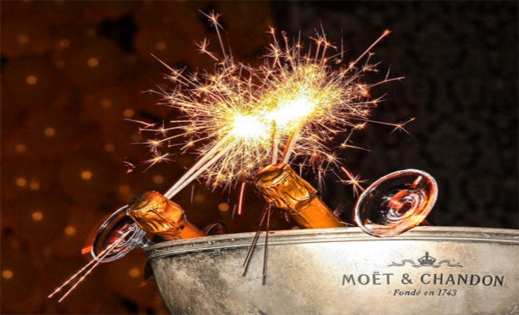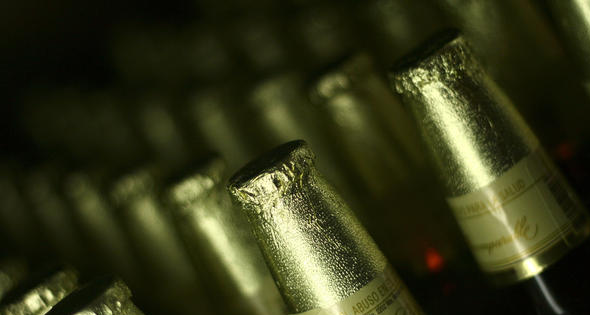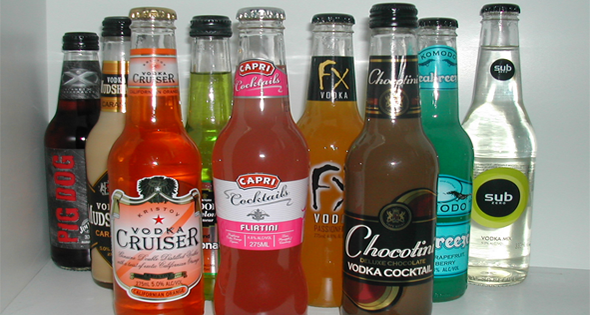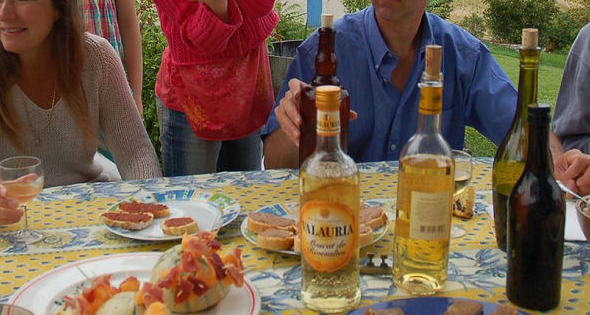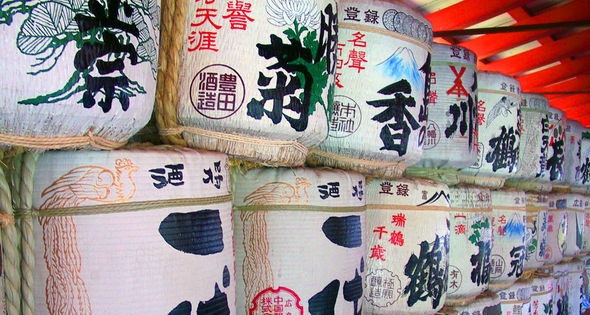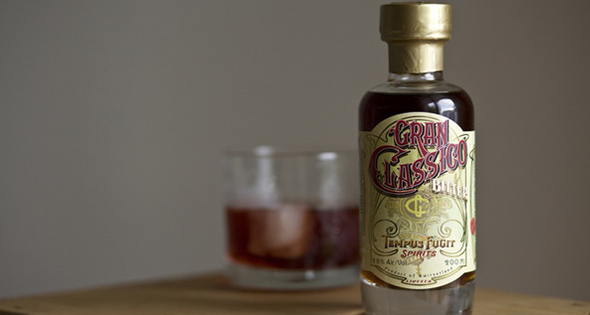Top 10 Champagnes for New Years
The Top Ten Champagnes to Ring in the New Year
New Year’s Eve is quickly approaching and the best drink to serve at your party is the classic wine that is used to celebrate special occasions: Champagne. Whether it’s the “true” Champagne from France or a delightful sparkling white wine from one of the other superior wine producing regions of the country, if you choose one of the bubblies from our list, your selection is likely to be a hit with all of your guests.
There are a few things to keep in mind when serving Champagne: it’s best served at about 460F or 7.50C and should be poured in tall flute shaped glasses so that it keeps as many of its delicious bubbles for as long as possible. Furthermore, it should be opened gently so that it keeps as much of its characteristic fizziness; popping the cork will make the beverage lose its bubbles. Finally, glasses should not be chilled; the subtle flavours will be eliminated if it gets too cold.
So, without any further ado, here are the Top Ten Champagnes for New Year’s Eve; we’ll start our list with sparkling white wines.
Freixenet Cordon Negro Brut
Price: About $10 USD
Type and Country of Origin: Sparkling white wine, Spain
Character: Dry and crisp, with citrus flavors
Serve with: Alone as an apéritif or with appetizers and seafood.
Just because this sparkling wine is inexpensive doesn’t mean it’s cheap or of inferior quality; Freixenet is a real crowd pleaser that will make wine novices and experts alike very happy.
Cordoniu Cava Brut Anna de Cordoniu
Price: About $18 USD
Type and Country of Origin: Sparkling white wine, Spain
Character: Clean, “biscuity” flavor, with a very light sweet note, yet still dry. Fruity notes.
Serve with: Alone as an apéritif or with a sweet dessert.
As far as reviews go, if you’re looking for a nice inexpensive sparkling wine that’s superior in quality to others in the same price range, you cannot go wrong with a bottle of Cava Anna.
Henkell Trocken
Price: About $10 USD
Type and Country of Origin: Sparkling white wine, Germany
Character: Crisp, with light melon and apple notes
Serve with: Alone as an apéritif cocktail or as the toasting wine to be used at midnight
A classic German sparkler that’s popular in restaurants in Canada and the U.S. when milestone events are held, if you’re looking for something affordable yet special, Henkell Trocken is a solid choice.
Hillebrand Trius Brut
Price: About $20 USD
Type and Country of Origin: Sparkling white wine, Canada
Character: Fruity aroma reminiscent of citrus with a nice long finish
Serve with: Appetizers, especially seafood or alone as an apéritif
While most wine connoisseurs may think of Canada as a producer of the heavier, sweeter ice wines, this almost surprising entry in the Top Ten list proves that this northern wine producer can more than hold its own in the sparkling wine industry.
Jansz Premium Cuvee Brut
Price: About $30 USD
Type and Country of Origin: Sparkling white wine, Australia
Character: Dry, clean, with an intriguing complexity consisting of the merest hint of fig.
Serve with: Alone or as the wine to toast the New Year at midnight.
Australia is another country that is making surprisingly good sparkling white wines. Usually known for big reds such as Cabernet Sauvignon and Shiraz, this southern hemisphere nation is giving traditional French Champagne some big competition.
And now, the French Champagnes. While they are more expensive, bottles of Champagne from the famous French wine producing region really do make special occasions even more memorable.
Krug Grande Cuvee Champagne Brut
Price: About $200 USD
Type: Champagne (white)
Character: Velvety, with hints of vanilla and exotic touches of ginger and coconut
Serve with: Food that is lighter in texture or as a sipping wine for the entire evening
In this case, price does reflect the quality; Krug Grande Cuvee Brut is perhaps THE all-round classic Champagne that is the preferred choice of wine experts. If you really want to splurge on New Year’s Eve, this is the beverage you want to serve to your guests.
Veuve Clicquot Brut
Price: About $60 USD
Type: Champagne (white)
Character: Nicely balanced and dry, with citrus and fruit notes and a delightfully unexpected soupçon of bread dough.
Serve with: Alone as a beverage before a meal, with seafood or with savory pastries.
While this drink is often served as an apéritif, there are those who claim that pairing Veuve Clicquot Brut with quiche or a pastry-based main course such as Salmon Wellington is simply divine.
Perrier Jouet Grand Brut
Price: About $50 USD
Type: Champagne (white)
Character: Golden straw color with a subtle taste and aroma of freshly cut apples; crisp on the finish.
Serve with: Alone as a sipping wine or as an accompaniment to main courses consisting of seafood or chicken.
If you want to keep your wine list simple for your New Year’s Party, then Perrier Jouet Grand Brut is the Champagne you’re looking for. Incredibly versatile, if can be an apéritif or can be paired with an incredible variety of appetizers and main courses.
Louis Roederer Brut Rose 1998
Price: About $65 USD
Type: Champagne (rosé)
Character: Flavors of plum, strawberries and cherries, very full bodied; deep golden salmon color and “biscuity” texture, lots of fine bubbles
Serve with: Salmon, lamb, veal, game, soft cheeses, and desserts featuring red fruit; can also be served as a crowd-pleasing sipping wine.
If you need a wine that will please a diverse crowd, this rosé Champagne, which is the only one on the Top Ten list, will certainly fit the bill. Like Perrier Jouet Grand Brut, it’s versatile and presents a lovely twist on the classic Champagne.
And the top Champagne to serve on New Year’s Eve…
Moet & Chandon Dom Perignon
Price: About $175 USD
Type: Champagne (white)
Character: Beautiful mineral flavors with hints of citrus; a long finish that connoisseurs describe as “toasty”
Serve with: Seafood, especially oysters or serve alone as an apéritif
If you’re going to go all out this New Year’s Eve with an exquisite meal consisting of the finest oysters and seafood delights, then you simply must have this classic French Champagne. The oldest brand of Champagne on the market, this is truly the beverage you need to drink in order to “taste the stars.”
Ceviche and Cancun’s Top Beers
Ceviche and Cancún’s Top Beers
Everybody goes to Cancún in the Mexican Caribbean to party; nightclubs and bars are the stuff of legend and make the traditional resort and party town of Acapulco seem tame and a little bit fuddy-duddy in comparison. But one thing that takes a lot of visitors by surprise is the fact that this resort on the Yucatán peninsula offers one of the most delicious dishes in the world: ceviche. And not only is the ceviche possibly the best you can find in Mexico, it’s possibly the best you’ll find in all of Latin America.
Ceviche, when it’s made in its most basic yet delicious form, is raw seafood and fish marinated in lime, chopped tomatoes, onion, coriander, green chillies and salt. It is usually eaten with plain saltine crackers or fresh, home-made tortilla chips. Due to health concerns though, it’s very hard to find places that use raw fish and seafood; most bars, restaurants and snack shops and stalls will use cooked shrimp and prawns for their ceviche.
This dish is absolutely fantastic on the beach, it’s great as a snack, and it’s great in the fanciest of restaurants, and the only thing that can make this dish even better is eating it with one of the fabulous beers that are available in Cancún. Here’s a look at the top beers a visitor must try either straight or with a plate full of ceviche to accompany it.
Yucatán Beers
The best part about travelling is sampling locally produced beer; and these two beers crafted in the Yucatan certainly do not disappoint. The two most popular beers among locals and savvy travellers are Leon Negra and Montejo Clara.
Leon Negra
This amber lager pours with a beautiful reddish-orange tinged light brown, and is has such a brilliant clarity that it almost sparkles. With just the right amount of carbonation, a lovely creamy head forms which lasts until the drink is almost totally consumed. Flavor and aroma-wise, it smells lightly of sweet toffee, sweet bread, and sweet malt. There really isn’t a hop aroma, which makes the beer smell clean and inviting. Tasting like a superior quality English brown ale, it is well balanced, lively, yet light. Leon Negra also has a nice, barely-there taste of caramel and is ever so slightly on the sweeter side of beers. This is a must-have beer for all visitors to Cancún.
Montejo Clara
While Leon Negra has been brewed in the Yucatan since the 1900, Montejo Clara is something of a Johnny-come-lately type of beer; although it doesn’t have the long history Leon Negra has, it’s become a traditional beer to order. This pilsner beer will be good for those who aren’t too keen on darker beers, and is also simply amazing with ceviche.
When it comes to appearance, Montejo Clara fans state it is “a golden elixir”, pale yellow in color but still rich-looking. Vigorous carbonation adds to the refreshment factor, and a peppery hop aroma is reminiscent of Dutch pilsners such as Grolsch. It’s floral scent has none of the faint smell of sulphur that some mass-produced beers may have and makes the beer incredibly enticing, especially during hot beach weather. As far as flavor is concerned, it is light, refreshing, but has depth of character that is on the same level as the most superior quality European pilsners.
National Beers
While in some countries national, mass-produced beers can be rather bland, unexciting, uninspired and insipid, Mexico bucks the trend and consistently produces good beer on a grand scale. While Sol and Corona are very good beers that are always enjoyable to drink, here are some internationally lesser-known beers that Cancún locals emphatically state are simply better.
Bohemia
A delightful darker amber beer that is not really known outside of Mexico but is considered to be, by far, the nation’s finest. It has a strong scent of caramel with a hint of chocolate, and has a bitter medium flavor that also tastes of smoky caramel. However, it’s surprisingly dry and has a light to medium body, which makes it perhaps nicer to drink at night-time in Cancún rather than during the day on the beach.
Noche Buena
This is a special amber beer that is only released once a year close to the Christmas holidays; if you’re in Cancún this winter, definitely give this one a try.
Dos Equis XX Special Lager
Along with Sol and Corona, Dos Equis XX Special Lager is perhaps THE beer to be drinking during the daytime on Cancún’s famed crystal-clear water beaches. As with all lager beers from Mexico, a slice of lime pushed into the bottle makes this beer go from regular to great.
And finally…Negra Modelo
This Munich dunkel lager was first brewed in Mexico back in 1926 by Austrian immigrants; the dark lager manages to be totally refreshing and is one of the very few dark beers that can be comfortably consumed on a hot beach and not feel overwhelmingly stuffing. Furthermore, because the beer is so delicately flavored, it is the ideal beer to have with an extra spicy portion of ceviche; the delicate taste will balance out and go well with the strong heat factor of jalapeño, Serrano, or other strong green chillies.
Tweet It! #CancunBeer
What is an Alcopop?
Alcopops
“Alcopop” is a term that is used by the general public in many countries but is not, in fact, used in the beverages industry. When people use the word, they usually mean single-serving pre-mixed drinks containing between 4%-12% alcohol by volume and juices, sodas such as Coca-cola, or other flavorings, colorants and additives.
Controversy with alcopop
Alcopops are usually very sweet and are produced in a way that a person can’t taste the alcohol; the alcohol becomes disguised and at times they can really taste like non-alcoholic beverages. Due to their bright colours, many critics of the alcohol industry in various countries feel that these beverages are being directly marketed to underage drinkers. In many cases, up until recently, “alcopops” were relatively inexpensive as well because they did not fall into the traditional categories of alcoholic beverage taxation laws. Because of problems in the 1990’s and 2000’s with underage drinkers consuming vast amounts of cheap alcopops, many national governments decided to dramatically increase taxes, making the cost of an alcopop somewhat more out of the reach of an underage consumer.
Types of alcopop
Despite the controversy over alcopops being marketed towards young adolescents, they have grown more acceptance among the older crowd and many actually prefer the pre-fab mixed drinks to beer, wine, or cocktails. There are several varieties of beverages that fall into the category of “alcopops”:
1. Wine coolers Introduced to the market in the 1980’s, wine coolers are a blend of white or red wine and fruit juices or carbonated soft drinks with other flavours. Some of the top brands of wine coolers were Bartles and James, Bacardi Breezer, and Canada Cooler.
2. Malt-liquor based beverages: In the 1990’s due to taxation laws in places like the United States which caused the price of wine coolers to go up, manufacturers found a way around this by producing sweet alcoholic mixed drinks with a malt beverage base. Technically, because of their malt base they were sold as beer products and enjoyed lower taxation rates. The malt base of these drinks was not hopped and were processed in a way to be almost flavourless, meaning the drink would taste the same as commercial soft drinks. Popular malt-based alcopops are Mike’s Hard Lemonade, Zima, and Smirnoff Ice. Producers of these beverages advertised heavily to young people and portrayed situations that young people would find themselves in.
3. Sprit based alcopops: These drinks are not disguised beer or wine; they are basically the same thing that a person could get at a bar, only served in a 330 ml can or bottle. While industry watchdogs claim that these spirit and soft-drink concoctions will appeal to younger drinkers, others quite rightly claim that the drinks contain far less alcohol than the drinks that would be prepared at home with a bottle of spirits and mixers.
Most spirit brands have their own range of ready-to-drink alcopops; some include Southern Comfort and Lemonade, Midori Melon & Lemonade, and Coruba & Cola. Other specific brands of spirit-based alcopops are Jack Daniel’s Hard Cola, Skyy Blue, and Six Degrees, which is based on absinthe.
Who drinks alcopop?
Because most of the alcopops that are available in the United States are flavored beer and are advertised to young women, alcopop is also called “cheerleader beer” or “chick beer”. The overwhelming majority of consumers are females who are under 21 years of age, which happens to be the legal drinking age in the country. People who are over 21 tend to view alcopops as “kids drinks” and there is a very strong stigma attached to drinking them. Women who are over the age of 21 usually do not like alcopops and claim they are far too sweet. Studies have shown that even the most dedicated of alcopop fans in the United States can only drink about 3 servings of alcopop in an evening; the amounts of sugar in the drinks can easily make a person feel nauseated. For this reason, some say that the media fuss over alcopops contributing to underage drinking is overblown.
However, in countries like Australia, alcopops are growing in popularity with the older crowd who want something different from a beer or a glass of wine. Alcopops are generally served with a glass full of ice and are considered to be refreshing. Making things interesting is the fact that men are also drinking alcopops. Again, due to the sugar content, people rarely have more than two.
In the United Kingdom, alcopops do seem to have contributed significantly to underage drinking and people who are of the legal age to drink do tend to shun them. Recent changes to taxation laws were enabled in order to combat underage alcohol consumption; while alcopops used to be very inexpensive, they are now out of the financial reach of most teenagers.
A northern alternative: the long drink
Europe has seen the same problem but higher taxes seem to have worked for now to prevent younger people from being able to purchase cheap alcohol. It must be noted that in countries such as Estonia and Finland, alcopops are not as popular as the traditional “long drinks” which are carbonated gin-based beverages with fruit flavoring that are also served in single-serve cans or bottles. Many bars and restaurants also have “long drink” on tap. Long drinks are popular with both genders and all ages; interestingly enough, underage drinkers will not drink alcopops at all but will acquire hard liquor, which can cause just as many or even more health and societal problems.
The verdict
If you like sweet drinks, then alcopops may be right for you. When taken in moderation, they can be quite delightful, but if too many are consumed, the sugar may cause nausea. Due to too many youngsters abusing the inexpensive alcoholic beverage, they are now no longer cost-effective, and for a sweet drink, you’re probably better off getting a properly prepared cocktail.
Tweet It! #Alcopops
Cheladas and Micheladas: Cancun’s Best Beach Drinks?
Cheladas and Micheladas: Are These Cancún’s Best Beach Drinks?
When it comes to beer, Mexico absolutely makes some of the world’s best. Almost every single brand, whether it’s from a national mass producer or a regional brewery that caters to local tastes, you can bet you’ll get a beer that’s tasty and refreshing, no matter what style you like, from lagers and pilsners to the darker amber and “black” beers.
Beer drinkers who decide to holiday in Cancún will have an absolutely fabulous time because most of the country’s top brews are available everywhere; if not in the bars or restaurants, they can be found in the city’s grocery stores. World-famous beers such as Corona and Sol are everywhere, and beer aficionados can also easily get “connoisseur beers” such as Bohemia (said to be the best in Mexico) and Negra Modelo.
The beer is great, no doubt about it. But while you’re in Mexico, why don’t you try a couple of the local specialties that will absolutely knock your socks off and make you think of beer in a totally different way? In a way that makes standard beer incredibly versatile? In a way that will make refreshing beer even more refreshing and flavorful on a hot day at the beach? Why don’t you try a Chelada and a Michelada?
Cheladas and Micheladas have been around in Mexico for decades, quite possibly for over a hundred years. If you’re a beer lover but want to try something a little bit different but not too crazy, and if you don’t like sweet, syrupy or thick cocktails, and if you’re not too keen on wine, then these two Mexican specialties are for you. While not technically seen as mixed drinks, there are some who call these two beer-based drinks cocktails. However, most people view the Chelada and Michelada as beer with extra goodness thrown in. And if you’re on the beach and it’s hot, nothing is ever as refreshing as a good cold Chelada or Michelada.
The Chelada
The Chelada is basically a lager beer (use Sol, Corona, Superior, Dos Equis XX or Tecate) poured over ice into a chilled glass that has a salted rim (sea salt is best); between one half ounce to a full ounce of lime juice is added. If the concept seems a little bit strange, think of it this way; a Chelada is like a beer margarita. But unlike a margarita that can get too sickly sweet or can be un refreshing, a Chelada provides just enough tang and salt to be an effective thirst quencher and tasty at the same time.
One thing to keep in mind however, is that for both drinks, it’s almost always best to use lager beers. While a Chelada made with Bohemia or Negra Leon might be interesting, darker beers are almost always better when consumed with no other adornment, garnish, seasonings, or additives. One can say that making a Michelada with Negra Modelo is sort of like making sangria with a vintage Bordeaux; it can be done, but there’s not really any reason to.
If you’re a person who’s a little bit more adventurous at heart, then you may want to try the Michelada, which some beer drinkers claim is a bit more “hardcore”.
The Michelada
The Michelada, when a person is first informed of its ingredients, sounds a bit counter-intuitive. However, the components work together in a way that is incredibly refreshing and can cool you down after a long session in a hammock at the beach. The Michelada, like the Chelada, is served over ice in a chilled glass that has a rim covered in sea salt. The exact same amount of lime juice is added, along with liberal dashes of Tabasco sauce, Worcestershire sauce, and in some cases, slices of Serrano chillies. Some bars and restaurants, to the delight of Canadian patrons who have the custom of pouring a shot of clamato (clam and tomato juice mixed together) or tomato juice in a pint of mass-produced lager beer to “improve” the taste, will even add a little clamato juice to the Michelada, effectively making a beer-based Caesar cocktail that’s more appropriate for Caribbean climes.
The “icy hot” effect is cooling
As mentioned, at first this drink may not appear to be particularly refreshing, but Mexicans emphatically state that the spiciness of the drink, along with the saltiness, tang, beer flavor and coldness all help you feel like you’re cooling down. At first the effect of a spicy cold drink is a little disconcerting, but after you try it a few times, it becomes very delicious and plain lager beer seems a little boring afterwards.
The best daytime drinks for Cancún’s beaches
In temperate climates, plain beer is really great, and in the Canadian situation, adding a little clamato juice to uninspired factory beer can make a cold winter evening go by in a pleasant fashion. However, when it comes to Cancún, beer needs to perform; beer needs to be refreshing, beer must cool you down, and it has to do the job in hot and humid conditions.
This is why the best drinks in Cancún during the daytime aren’t your typical frilly cocktails; although delicious, they might only be effective in getting you drunk, but even then they may be too heavy, syrupy, and thick to drink during the full heat of the mid-day sun on the beach. Cancún’s best drinks for daylight hours consumption are the Chelada and Michelada.
If you’re planning a trip to Cancún and you’re a little afraid of trying a Michelada or Chelada, you can always ease your way into it by first trying some lime juice in your beer without any salt or ice, and ask the bartender to gradually add more ingredients in successive rounds. In no time at all you’ll be a beer drinks expert, staying cool and refreshed in Mexico’s beautiful Caribbean.
Tweet It! #Cheladas
What Your Drink Reveals About You
What Your Drink Reveals About You
Like body language, the clothes you wear and the products you use will say a lot about you. The types of drinks you order while at the pub, bar or nightclub will also reveal some of your subconscious characteristics to others. What you drink speaks volumes about you. Here is what your drink says about you to other patrons.
Domestic draft beer: You’re a hardworking person, possibly in the trades and blue collar. You don’t want anything fancy, just a plain’ old beer at the end of a hard day’s work. You tend to be easy to get along with. You are suspicious of “weird beer” whose names you don’t recognize.
Imported European beers: You might be well educated, and you like the more intense flavour of a German, Dutch or Belgian beer. Or you might want people to think you’re foreign or you want to show off your knowledge of beer. Or maybe you just want to appear more sophisticated than you actually are.
Craft or microbrewery beer: You’re a person who wants more than what a mass-produced beer can offer; you want to adventure a little bit without going overboard. However, by constantly yakking about how awesome microbeers are and criticizing other people’s tastes in domestic draft, your drinking companions will get fed up of your windbaggery. Craft beers are great, so spread the word in a good way, not by disparaging other’s choices.
Guinness beer: In a North American context, drinking a Guinness means you’re a serious beer drinker; not many can take the thick consistency, black color and heavy flavors. By ordering a Guinness or any other stout beer, you’re basically telling the bartender: “I know exactly what I’m doing and I appreciate a good drink.”
Long Island Iced Tea: “I want to get drunk in the least painful way possible!” This is usually a favorite with those who have just reached the legal drinking age; it’s a drink that is strong and goes down easily. It’s not particularly popular with the over-30 crowd; a 40-year old ordering one might raise a few eyebrows.
Grand Marnier or any other fine liqueur: This shows that you know about the finer things in life and that “trendy” cocktails don’t really matter to you. By ordering one of these, the bartender or waiter will know that you’re a true connoisseur of alcoholic beverages.
Red wine: You’re over thirty, probably highly educated, and like to read. You probably prefer settings like a pub over a nightclub as you like to have a conversation with your friends and companions.
White wine: You’re probably female, over 40 years old, and blond. You don’t like beer or sugary cocktails, and you don’t like to stick out too much. However, if you order a glass of white wine to pair with food that you’re ordering, you’re probably a wine connoisseur of either gender.
Gin or vodka Martini: You’re probably a well-off white collar office worker who’s had a very bad day and is in need of a good stiff drink. Or you’re a kid who’s trying to look sophisticated by ordering one. If this is the case, as soon as you take a sip, you’re probably going to make a face and you’ll get called out on your “sophistication”.
Bloody Mary or Caesar: If you’re drinking a Bloody Mary, you’re probably nursing a hangover. If you’re drinking a Caesar, you’re probably just Canadian.
Gin and Tonic: You’ve probably got lots of money, but you’re discreet about it. Or you might be an archaeologist/social anthropologist.
Single malt Scotch: You’re probably rather wealthy, or you’re highly educated, or quite possibly both. You’re accomplished but don’t like to brag about your achievements, and you’re also contemplative. And you’re probably over 30. If you’re younger than 30, you tend to be a bit pretentious.
RedBull and Vodka: A popular drink amongst the hard-partying university students who want energy yet still want a buzz from alcohol. If this is your drink of choice, you probably don’t mind that you don’t remember much from the night before.
Fruit Margaritas: You’re a lady who’s ready to P-A-R-T-Y. If you’re male, you’re comfortable in your own skin and don’t give a flying flip what people think of you. You like what you like.
White Russian: If you’re a man and you order this, you’re probably a fan of The Big Lebowski, talk about The Big Lebowski, and maybe even dream of a Big Lebowski remake. And you’ve probably got an “ironic” moustache or a tattoo of chopsticks on your forearm. Or both.
And finally….
Tequila shots: If taken at the start of the evening, you’re probably in your mid-twenties, a person who’s fun-loving and wants to get the party started; you’re crazy in a good way. If tequila shots are your drink of choice at the end of the night when the clubs are closing, you might be the type who’ll get into fights in the parking lot or have no idea how on earth you ended up in a stranger’s bathroom. You’re crazy in a bad way.
Fine Tequila, slowly sipped with either a beer or sangrita chaser: You’re a person who’s either been to Mexico or knows that good tequila is best enjoyed when sipped over a period of time. You are understated charm and sophistication, probably educated and enjoy a great night out without letting things spin out of control.
Tweet This! #Drinking
Top 10 Wine & Spirit Christmas Gift Ideas
Our Top Ten Selection of Wine & Spirits Gift Baskets
Getting the perfect gift for that special someone, co-worker, friend, or relative is always a difficult task and when one needs to purchase the gift in a hurry (due to forgetting a certain date or special occasion until it’s almost too late); it can be downright panic-inducing. Not only does one need to get the gift, one needs to get a gift the recipient will like, and furthermore the peripheral gift-giving duties such as wrapping and presentation must also be done.
At 1-877-Spirits.com, a wonderful solution is offered to those who simply must present a substantial and thoughtful gift but need a lot of help; 1-877-Spirits.com offers specially made gift baskets in beautiful storage containers and lots of extra goodies that will be sure to thrill the recipient to bits. Not only do they attractively arrange and wrap their gift baskets; they will also have the gift baskets promptly delivered by Standard Delivery with a personalized gift card so that the recipient will receive the unexpected and delightful gift in their mail.
Here are our Top Ten Spirits Gift Baskets that 1-877-Spirits.com currently has on offer.
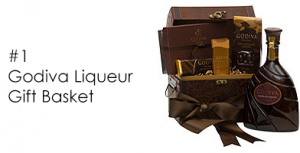 The Godiva Liqueur Gift Basket Godiva chocolate liqueurs are described as heavenly, smooth and rich, which make them perfect for any chocolate lover. The $159 USD price tag includes a beautiful bottle of the liqueur and high-end assortment of Godiva chocolates, all packaged in a re-usable trunk. The price also includes Standard Delivery anywhere in the Continental U.S. Order It Now!
The Godiva Liqueur Gift Basket Godiva chocolate liqueurs are described as heavenly, smooth and rich, which make them perfect for any chocolate lover. The $159 USD price tag includes a beautiful bottle of the liqueur and high-end assortment of Godiva chocolates, all packaged in a re-usable trunk. The price also includes Standard Delivery anywhere in the Continental U.S. Order It Now!
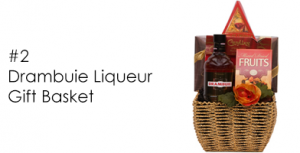 An absolute must-have for those who enjoy whiskey liqueurs, this gift assortment includes a bottle of Drambuie whiskey liqueur, chocolate, cheese, crackers and an assortment of dried fruit and comes in a beautiful gold wire basket. The all-inclusive price which covers Standard Delivery in the Continental U. S. is $161. Order It Now!
An absolute must-have for those who enjoy whiskey liqueurs, this gift assortment includes a bottle of Drambuie whiskey liqueur, chocolate, cheese, crackers and an assortment of dried fruit and comes in a beautiful gold wire basket. The all-inclusive price which covers Standard Delivery in the Continental U. S. is $161. Order It Now!
 The Montgras Quatro Three Bottle Wine Set Although not technically a gift basket, this gift set of three high quality wines will be sure to please the person who enjoys a great glass of dry red. Included are Faustino I Gran Reserva Rioja from Spain, Santa Rita Medalla Real Cabernet Sauvignon from Chile and Montgras Carmenere Wines, also from South America. $155 includes the cost of Standard Delivery anywhere in the Continental U.S. Order It Now!
The Montgras Quatro Three Bottle Wine Set Although not technically a gift basket, this gift set of three high quality wines will be sure to please the person who enjoys a great glass of dry red. Included are Faustino I Gran Reserva Rioja from Spain, Santa Rita Medalla Real Cabernet Sauvignon from Chile and Montgras Carmenere Wines, also from South America. $155 includes the cost of Standard Delivery anywhere in the Continental U.S. Order It Now!
#4 Crown Jewel –Crown Royal Canadian Whiskey Gift Basket The ideal gift for an outdoorsman or anyone who enjoys a good rye whiskey, this gift basket comes in a gorgeous wooden bottle carrier filled with Godiva chocolates, cookies, and cheese spread along with a bottle of Crown Royal Reserve Whiskey. $176 includes delivery in the Continental United States. Order It Now!
#5 Chocolate Wine Gift Basket
This is also a very good gift to consider for the chocoholic on your list, especially if that person is not too keen on liqueurs and prefers the lighter texture of a wine. At $85 including delivery, this bottle of chocolate wine with its accompanying selection of gourmet chocolates is sure to be a hit with the recipient. Order It Now!
#6 Wine Gift Basket
Shimmering Cheers If you need to get a nice gift for an employee or for a wedding, the Shimmering Cheers basket is the best solution: not only does it come with a bottle of red wine and a bottle of white wine, it comes with a shimmering , attractive two-bottle wine holder and an easy-to-use corkscrew. $95 includes Standard Delivery to all places in the Continental U.S. Order It Now!
#7 Champagne Gift Basket
Bucket Of Bubbly This is the gift for very big occasions; a friend or relative’s wedding, celebrating a big promotion, or a milestone birthday or an anniversary. For $275 which includes delivery, the beautiful champagne bucket is filled with three high quality bubblies, gourmet chocolates, cheese spreads, crackers, salmon spread and biscotti. Order It Now!
#8 Bombay Sapphire Gin Gift Basket
Sapphire Blue If one needs to get a gift for a person who loves good, flavourful and fragrant martinis done the right way, The Bombay Gin Gift Basket is by far the best choice. Featuring one of the best and most iconic gins available on the market, the gift basket also comes with gourmet chocolates and cookies in a rustic-looking wicker basket. Delivery is included for $125. Order It Now!
#9 Patrón Tequila Gift Basket
Shake It Up For the aspiring bartender who wishes to whip up his or her own personalized margaritas,, nothing could be better than this gift basket, which at $149 includes delivery anywhere in the Continental U.S. Featuring the well-reputed Patrón Silver Tequila, fresh limes, a drink shaker, margarita mix and nuts are added to the gift, which is all packaged in a faux leather container. Order It Now!
#10 Ultimate Collection Gift Basket
Not everybody drinks alcohol, and the people at 1-877-Spirits.com have kept them in mind too, offering a fabulous selection of non-alcoholic gift baskets. The best of these gift baskets is the Ultimate Collection, which includes fudge, cheeses, crackers, dried fruit and gourmet chocolate in a beautifully built wood-hinged box for $99. As with all the other gifts on offer, delivery is included in the price to anywhere in the Continental U.S. Order It Now!
Gift giving doesn’t have to be hard; a quick call to the people at 1-877-Spirits.com can help one find the perfect gift in a short amount of time. And while many will find the perfect present for someone else, they will probably also find a little something that they might want to get for themselves.
Tweet It! #WineSpiritsGifts
What is an Aperitif?
What is an Apéritif?
Some of the lingo that’s used in the alcoholic beverage industry can be a bit confusing to a newcomer or even a person who’s familiar with things such as beer, wine, and cocktails. An apéritif is one of those words that get used quite often but funnily enough, not very many people know what it actually means. Most people with a solid knowledge of fine alcoholic drinks claim that the aperitif is simply a drink that is consumed before a meal. However, there is actually much more to it than that; therefore, here we will explain what an aperitif is and when it should be taken and we will conclude the mini-lesson with our top five choices of aperitifs.
How to Say It
First of all however, a pronunciation lesson is needed. Apéritif comes from the French language and is pronounced “a-pair-ee-TEEF”, not “AA-peratif” or “a-PER-ative”. Practice saying the word out loud a few times. You don’t need to pronounce it like you’re from Paris; just remember to stress the word on the last syllable and you’ll be fine in any tony restaurant or bar.
What it Is
An aperitif is indeed an alcoholic beverage that is served before a meal; however, it isn’t any old drink. It must be an alcoholic drink that is specifically consumed to stimulate the appetite. In other words, it’s a drink that will make you feel hungry or will prepare you for a meal. In some cases, the word apéritif may refer to a small snack that is served before a main meal; however, in most English-speaking situations, apéritif refers to the drink, and “appetizer” refers to the small snack.
The word comes from the Latin verb aperire which means “to open”. By consuming a light alcoholic beverage before a meal, you are in fact, “opening” your appetite.
Apéritifs are usually light-bodied and do not contain heavy ingredients such as cream, eggs, or excessive amounts of sugar which would kill an appetite and make a person feel “stuffed.” Still, dry, and light white wines can be used as a before-dinner drink and are a popular choice.
A Brief History
Apéritifs were introduced to the world as a specific drink in 1846, when French chemist Joseph Dubonnet, as a way to deliver the incredibly bitter malaria-fighting chemical quinine in the most pleasant manner possible, developed a wine-based drink flavored with spices and herbs to mask the bitterness. The resulting beverage was so pleasant, that Dubonnet is still a very popular drink to this day and has ardent aficionados all around the globe.
However, before 1846, aperitifs were being consumed in Italy since the 1700’s. Vermouth was developed in Turin by Antonio Benedetto Carpano in 1786, and present day vermouth brands that are still popular are Martini, Cinzano, Dolin, and Noilly Prat. By the 1900’s, apéritifs were common everywhere; the trend had even crossed over to North America.
It must be said that apéritifs in Spain and some parts of Latin America have been around for centuries; or in the case of Spain, possibly for over a millennia. In the Iberian Peninsula, it has been a tradition for eons to have a light drink before a meal, and the drink is almost always accompanied by a snack. This drink-and-snack tradition is known by its Spanish-language name of tapas.
Common Types
The types of apéritif are incredibly varied. The most popular are fortified wines such as Madeira, Sherry, or white Port wine; some liqueurs are also used as apéritifs, and many people, especially in the United States, like to have white wine or champagne before a “fancy” meal.
In France, some of the common apéritifs are pastis, which is taken before meals in the southern part of the country, Calvados brandy is a favorite in Normandy, and Crémant D’Alsace, a type of sparkling white wine, is taken in the eastern regions. Champagne and Cognac are also frequently served in homes as dinner apéritifs. Kir cocktails, the recipe for which is below, are famous in France and are becoming more well-known in North America. Young, fresh red wines like Beaujolais Nouveaux can also be used as pre-dinner drinks.
In Italy, bitters (alcoholic beverages that are herbal in nature with a bitter taste) such as Cinzano, Campari, Byrrh, Salers and Suze are often used as before-dinner drinks. Vermouth and amaro are also popular items in bars and in homes alike.
In Greece, a popular and almost iconic drink to have before eating a meal is ouzo, an anise-flavored beverage, while in the Eastern Mediterranean nations of Palestine, Israel, Syria, Lebanon and Jordan, arak is the apéritif of choice.
Our Top Five Picks
If you’ve never had an apéritif before, we recommend these top five to try:
1. Dubonnet Pronounced “doo- bon-NAY”, this beverage has been a favorite for over a hundred and fifty years now with people on both sides of the Atlantic. Sweet, herbal flavored and with a rather delightful hint of bitterness, a glass of Dubonnet on the rocks is the ideal way to start a dinner party with friends.
2. Kir cocktail This refreshing pre-dinner beverage is flavorful without being overpowering and has the power to make you enjoy your food even more. It’s easy to make: Simply pour an ounce or two of blackcurrant liqueur in a champagne flute, and fill the glass with a light white wine. To make a Kir Royale, use sparkling white.
3. Pastis This apéritif is clear and anis flavored; however, it is usually taken with water added to it, which will change the color to a milky white. If ice is desired, it should be added after the water has been poured into the glass or else the consistency will change; the cold will crystallize the anethole present in the liquor.
4. Campari and Soda Campari is one of Italy’s most famous bitters, and while it may be too bitter to drink on its own and has been described as “an acquired taste”, when it is mixed with soda water or even sparkling water it develops into something quite sublime.
5. Sherry A beautiful fortified wine from the Jerez region of Andalusia in southern Spain, a Sherry is like an amplified version of a great white wine. A must-have if you’ve never tried it before.
Tweet It!: #Aperitif
Sake: Japan’s Rice Brew
Sake: Japan’s Rice Brew
Everybody loves Japanese food; sushi, sashimi and countless gastronomical delights are pleasing to the palate for people all over the world. However, when you read some magazines or internet articles, some “experts” will recommend pairing western-style wines with Japanese food. While I’ve always been of the opinion that you should drink whatever floats your boat, when it comes to Japanese food, you’re probably better off accompanying your meal with a nice crisp Japanese beer or better yet, have some Sake (pronounced SAH-kay).
Basically speaking, Sake is an alcoholic beverage that is made from fermented rice. In Japanese, sake actually refers to any kind of drink containing alcohol; when the term is used in English it actually refers to what the Japanese call nihonshu or “Japanese liquor”.
Some people think that Sake is rice wine; however, it is not made with a wine-making method, sake is made from a brewing process that is sort of like the process used for making beer. In beer brewing, the starches need to convert to sugar, and then the sugar converts to alcohol; when Sake is made, everything happens simultaneously. Sake usually has an alcohol content of about 15%, higher than that of both beer and wine.
Sake has been around for well over a thousand years; originally a government monopoly, temples and shrines began to brew their own Sake in the eleventh century. In the 1860’s, laws were introduced that allowed anybody who had the brewing know-how to open their own brewery, and as a result, some 30000 breweries opened, the best of which are still open and operating today.
While Sake consumption inside Japan has been steadily decreasing since the 1970’s due to competition from other alcoholic beverages such as beer, the brewed rice beverage has increased in popularity outside the country to such an extent that Sake breweries are popping up in other countries and are using traditional, pre World War II methods of brewing.
Taste and Flavor
Sake can vary greatly, from sweet to savory and can have an extraordinary number of flavor notes. The label on a bottle of Sake will indicate the content’s general flavor characteristics. Here are some of the terms to look for when you’re considering sampling Sake.
• Nihonshu-do refers to the sugar and acid content of the liquid. If the number next to this expression is a negative, it means that the Sake is sweeter or “heavier” than water; if the number is positive, it means the Sake is drier or “lighter” than water. +10 indicates a very dry Sake, while -10 indicates a very sweet one.
• San-do is an indicator of acid concentration, determined by titration, or quantitative chemical analysis. Sweeter Sakes generally have a higher amount of acid so that they do not seem “cloying”.
• Aminosan-do can indicate savoriness. A lower aminosan-do value will indicate that the Sake will be thinner; higher values indicate more viscosity and rounder flavors. A higher number will also indicate a taste of umami.
Flavor notes can include bananas, melons, apples, herbs, rice, spices, chocolates, dry grapes, sherry and caramel sauce.
Serving Sake
Contrary to popular belief outside of Japan, Sake is not always served hot; in fact, it’s a question of personal preference; the beverage can be served chilled, warmed, or at room temperature. It all depends on the drinker, the type of Sake, and the season. Hot Sake is usually for the winter-time, and good-quality sake is never heated. Heating is good for low-quality or old sake because the heat will mask inferior aromas and flavors.
Everyday Sake is usually taken in small cylindrical cups called choko. The Sake is usually kept in a sort of flask or thermos that is made from ceramic material which is called a tokkuri. For special occasions such as weddings or ceremonies, flat saucer-like cups called sakazuki are used, and now there are special footed glasses made for use with premium-quality Sake. Box-cups called masu are also traditionally used. At some finer Japanese restaurants, as a show of generosity, a server may put a small glass inside a masu, fill it with Sake, and allow the glass to overflow to the extent that the masu also gets filled with Sake. In some cases, a masu might be placed on a sakazuki and both will be filled the same way.
Sake is almost always served straight, but some cocktails such as the Saketini and the Tamagozake can be made and are quite good.
Saketini
1 martini glass, chilled
2 ½ oz gin
½ oz sake
1 martini olive
Pour the gin and sake in a cocktail shaker with lots of ice; stir for approximately 30 seconds. Strain into the martini glass and garnish with the olive.
Tamagozake
This cocktail has been referred to as “Japanese eggnog” and is a home remedy for a cold or flu.
1 mug containing about 200 ml of hot sake
1 raw egg
1 teaspoon sugar or honey (use more or less to taste)
Whisk the raw egg and honey or sugar together, then add the mixture to the sake, whisking it. The egg will become lightly cooked; do not put the egg mixture in boiling sake as this will only serve to scramble the egg.
Other uses
Sake is also consumed during religious ceremonies, especially during Shinto rituals of purification.
The next time you go out to a Japanese restaurant or even if you just want to try something a little bit different, try some Sake, and it could very well turn out to be one of your new favorite beverages.
Tweet It!: #Sake
What is a Digestif?
What is a Digestif?
Technically speaking, a digestif is an alcoholic beverage that is taken after a meal to help with digestion. When a digestif is taken after a coffee course, it is called a pousse-café. Digestifs are more of a European tradition; however, in the past few years, European restaurateurs in the United States have been introducing the digestif concept to North America, where more and more people are enjoying the idea of more leisurely meals.
Digestifs have been around in Europe for a long time. Originally thought of as an aid to digestion after eating a heavy, rich meal, a digestif is a bit different than wine in that the flavors can be a bit bitter due to herbs that are used in the digestif concoctions to settle the stomach. While some digestifs can be sweet, they can also be a bit more neutral as far as sweetness is concerned; because a digestif is served after a dessert, many people don’t want to get a sugar overload but do want to enjoy a drink that won’t clash with the food that has just been ingested. For example, having a glass of Malbec wine after a eating a pudding probably won’t be so nice. However, a couple of ounces of something with a faint bitter, herbal taste and a touch of sugar will most likely be delightful. Basically, what it comes down to is personal preference. While an apéritif should not be sweet in order to whet the appetite, a digestif can be as sweet or as dry as a person likes.
Digestifs are usually very high in alcohol content, and drinks that are 35-50 % alcohol by volume are the norm. The reason why these are served at the end of the meal is two-fold: first, as mentioned above, it’s to help a diner’s digestion; second, if a highly alcoholic beverage is served before a person eats, on an empty stomach, a person can become highly inebriated. Only small amounts of a digestif are served; the hypothesis is that a small amount will aid the digestion, but too much will hinder it.
While in North America there is the habit of rushing through a meal and restaurants don’t like patrons who linger over after-dinner drinks, some finer establishments are re-introducing the idea of the coffee course and digestif for their clientele who like to make an evening of dining out. Other people are starting to serve the digestif in their homes during dinner parties in order to keep a good after-dinner conversation going. Serving a digestif adds another layer of sophistication and fun when entertaining in-house.
So where does one start when it comes to serving a digestif? Well, a very basic rule of thumb is that clear liquors work best as apéritifs, and dark liquors such as dark rum, scotch, and brandy work best as digestifs. But one must keep in mind that these are not the only things that are served as after-dinner drinks. Here is a look at some typical digestifs from European countries.
In France, after a meal, a variety of liqueurs may be served, and along with the liqueurs, an eau-de-vie may be offered. Eau-de-vie (or eaux-de-vie if there is more than one) is a clear, colorless fruit brandy that is made by the process of fermentation and double-distillation. The flavor of the fruit is very light, and the alcohol content can be up to 60%. Pronounced “oh-da-VEE” (the plural form is pronounced the same way), this brandy can be home-made, but many good brands are available. The French also will drink Armagnac, Calvados and Cognac, which are all well-known, highest quality brandies. French people will also say that the longer these brandies have aged, the tastier and subtler they will be.
People in the UK and in Europe will also have Sherry, Madeira and Port wines as a digestif; in fact, this is where the idea of “a Port and a cigar” after dinner comes from. However, some “purists” will consider these three fortified wines to be more “dessert wines” than technical digestifs.
In Italy, a common digestif is Amaro, which is Italian for “bitter.” The alcohol content can range from 16% to 35%, and the bittersweet liquid is usually served neat, or without ice, after a meal. Grappa is also an iconic digestif: the crystal-clear digestif is produced from the remains of grapes after they are pressed for making wine. Limoncello, a spirit that is flavored with lemon peels, is also a wonderful digestif.
But what are the best digestifs?
If cognac, brandy and whisky aren’t how you would like to end a meal, don’t worry; when it comes to digestifs, personal preference rules the day. Your digestif can be as sweet or as dry as you like. Here are a few suggestions to end your dinner party on a high note.
Sweet: Try Amaretto, an Italian almond liqueur, or Frangelico, a hazelnut liqueur with herbal notes. Bailey’s Irish Cream and Kahlúa are also popular liqueurs that are nice after eating.
Bitter and herbal but still sweet: Benedictine or Chartreuse. These two digestifs are sweet and herbal flavored, with Chartreuse being more pungent and spicy.
Sweet but not syrupy: Sweeter versions of Sherry, Port wine or Madeira.
Strong and flavorful: Eaux de vie, añejo (aged) tequila, dark rum, spiced rum.
Cocktails: The Old Fashioned. Put a teaspoon of granulated sugar in a glass, and add a teaspoon of water, and a few drops of Angostura Bitters. Muddle everything together, then add two ounces of bourbon whiskey and some ice. Add an orange slice and a maraschino cherry.
A leisurely meal at the end of the day is a beautiful thing. Take a bit of time, have some friends over, and enjoy great after-dinner conversation while trying something new. You’ll find that adding a digestif takes everything to the next level.
Tweet It!: #Digestif
Pernod and Pastis: How to Drink Them Properly
Pernod and Pastis: How to Drink Them Properly
Pernod and Pastis are both anise-flavored alcoholic beverages from France that took the place of absinthe when it was banned in 1915. Although the licorice-flavored drinks are similar in taste to absinthe, Pernod and Pastis do not contain the herb wormwood that was absinthe’s “active ingredient”.
The drink is especially popular in southern France, where it is taken as both a long drink and as an aperitif. Both beverages are also commonly found among the European ex-pat community in North Africa.
People who try Pastis or Pernod for the first time make the mistake of drinking it neat; this is not the right way to enjoy the liqueur for all of its more subtle flavors cannot be released when taken straight. Here is a little bit more information about the drink and how it should be prepared in order to enjoy all of its amazingly refreshing qualities.
Pastis and Pernod are very similar to other anise-flavored liqueurs that are consumed in the Mediterranean. It is very much like arak, raki, and Sambuca. Unlike its predecessor absinthe, Pastis and Pernod are always bottled with sugar and contain 45-50% alcohol by volume. The French liqueurs are also made with star anise, which comes from Asia; they are not made with the European green anise herb.
Serving Pastis and Pernod
As mentioned earlier, people who don’t have much experience serving and drinking Pastis can sometimes make the mistake of either drinking the liqueur neat or serving it over ice. Neat Pastis is far too strong to be enjoyed on its own, and when it is poured directly over ice, the anethole contained in the liquid will crystallize, making the drink chalky and kind of bumpy.
Pastis must be diluted with water. The standard measures for a proper drink of pastis are one part pastis to five parts of water. The pastis is poured into the glass first, followed by the water. Oftentimes, in restaurant situations, pastis will be served neat in a tall glass, but a jug of water will be given to the customer in order to add the amount of water he or she likes.
Pastis is meant to be a refreshing drink on hot days or served as an apéritif to whet the appetite before a big meal. While purists claim that ice cubes should never be added, they can be, but must be added after the water has been poured in so that the anethole doesn’t crystallize. Many people say that pastis tastes best if only cool spring water is used to dilute it.
One thing that happens once water is added; the beverage will change color from a transparent yellow or amber color to milky white. This is because when the water is added, some of the ingredients in Pastis become insoluble.
Pastis and Pernod are the most popular beverages in France; more than 130 million liters of Pastis are sold each year in the country, which is roughly equal to two liters per resident.
Drinks containing Pernod or Pastis
Pastis and Pernod are also used to make a variety of cocktails. While the above method of serving and drinking the liqueurs is the most popular, these are also drinks that have quite a few fans in France and around the world.
The Mauresque
1 tall glass
1 ounce Pastis or Pernod
1 ounce orgeat syrup (sweet syrup made of almonds, rose water or orange blossom water, and sugar)
Chilled mineral water
Pour the Pastis and orgeat syrup in the glass. If serving to another person, serve the water separately. Fill the glass with water; if desired, top up the glass with ice cubes.
The Perroquet (The Parrot)
1 tall glass
1 ounce Pastis or Pernod
1 ounce mint syrup
Chilled mineral water
Pour the Pastis and mint syrup in the glass, fill to the top with chilled mineral water, and add ice cubes if so desired. The correct pronunciation for this drink is “pair-oh-KAY”, not “PurroKWET.”
The Tomate
1 tall glass
1 ounce Pastis or Pernod
1 ounce grenadine
Chilled mineral water
Called “the tomato” because of its vivid red color, the Tomate is made by pouring the Pastis and grenadine in a tall glass and filling it with chilled mineral water. Ice cubes may be added if so wished.
The Mazout
The Mazout is made in the same way as the other drinks above, but instead of water, cola is used to fill the glass. Again, ice may be added after the cola has been poured in.
The Cornichon (The Pickle)
The Cornichon is made by mixing Pastis with banana syrup and filling the glass with mineral water. There are no pickles or cucumbers involved in this cocktail at all. Why it is called a Pickle is something of a mystery!
The Rou Rou
Made exactly the same way as the above drinks, but with strawberry syrup. Again, ice may be added if so desired.
Pastis and Pernod, while they may not be popular in North America just yet, they most certainly will become more and more well known as Americans and Canadians search for a little something different to drink before or during their meals. Whether you try Pastis and Pernod with either plain water or the different syrups mentioned in our drinks list, you’re sure to find a tasty, subtle drink with a delightfully different flavor you’ll want to try over and over again.
Tweet It!: #PernodPastis
